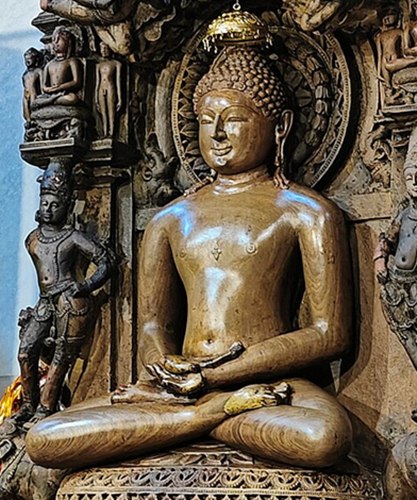Sanjay Sonawani
Previous Part of this research paper: The Early History of the Yoga
Yoga in Jainism
Since the name “Jin” means “one who conquers inner troubles,” it hints at the origins of Yoga. The Jain tradition says that the first Tirthankara, Rishabhnatha, was the inventor of Yoga, also known as vrata. Rishabhnatha is believed to have lived around 3000 to 2700 BC and is considered a historical figure. With no other sources to compare, it’s reasonable to say that the Samana movement started with Rishabhnatha. This movement later split into many philosophical schools, each with its own ideas, leading to several different sects.
I explained that while most philosophical groups eventually accepted the term “Yoga,” it originally came from the word “Vrata,” which means vows. People who strictly followed these vows were called Vratyas. From the descriptions, we know that Vratyas were wanderers who gave up worldly life because of their vows. Jainism is based on Vratas like non-violence (Ahimsa), truthfulness (Satya), non-stealing (Asteya), celibacy, and non-possessions. These Vratas form the foundation of what we now call Yoga, as they require control over human tendencies. Patanjali, in his Yoga Sutras, also includes these five Jain Vratas as Yamas (ethical rules).
Over time, the term “Vratya” fell out of favor because the Vedic supremacists tried to claim credit for ideas they did not create. By the third century BC, “Yoga” became the more popular term, but it still had the same basis in Vratas.
In fact, Patanjali describes Yamas, which are Vratas or vows, as the first part of Yoga. The second part is Niyama, which includes supporting Vratas, followed by Asanas (physical postures).
The “Bhagavati Sutra,” the fifth Jain Agama, contains Lord Mahavira’s teachings, which were written down in 466 AD during the last Jain council at Vallabhi. Before this, the teachings were passed down orally. In this sutra, Lord Mahavira explains to Somila that his way of life includes six practices: 1. Tapa (austerity), 2. Niyama (discipline), 3. Sanyama (self-control), 4. Svadhyaya (self-study), 5. Dhyana (meditation), and 6. Avashyaka (performing essential duties with self-awareness). (Source: “Bhagavati Sutra,” Vol.1, translated by K.C. Lalwani, published by Jain Bhavan, Calcutta, 1999).
Yoga in Jainism

In the Yogsutra, Patanjali talks about important principles called Yama and Niyama. For example, “Saucha” means mental purity for Jains, but Patanjali focuses more on physical cleanliness. Jains recognize bodily postures, called Asanas, as part of their yoga practice, especially under “Kayaklesh-tapa” and as one type of external self-discipline. However, Patanjali sees Asanas as a way to practice and achieve spiritual goals. The Yogsutra explains the different parts of yoga with various names and viewpoints. Overall, the Yogsutra expands on the Jain or Samana methods of meditation as a path to salvation.
The origins of the Yoga system, linked to the Samanas or Jains, are clear from the gradual development seen in Jain scriptures. Jain Yoga focuses on a four-step path to freedom: 1. Right faith, 2. Right knowledge, 3. Right conduct, and 4. Right austerity. Even though later schools adopted these paths under different names, the core principles remained unchanged.
To the Jains and leaders of the Samana movement, Yoga originally meant “Vrata.” Vrata, which required specific practices, was likely the earliest term for Yoga and formed the basis of the Yoga philosophy later detailed by Patanjali. The Vratyas, mentioned by early Vedic Aryans, were the Yogis of their time, practicing a new form of discipline. Vrata was always a personal effort to achieve enlightenment and liberation; it wasn’t about connecting with an external supreme force. In the early Jain philosophy, Yoga referred to the process where karma’s impulses clung to the soul, blocking its true brilliance.
Yoga in Jainism
However, according to Christopher Key Chapple “Responding to a shift in cultural usage of this term that probably arose during the later Upanisads, Jaina thinkers began to describe their religious practice in light of new definitions of Yoga as referring to techniques employed to achieve a state of mental quiescence.” (Yoga in Jainism, Edited by Christopher Key Chapple, pub.-Routledge, 2016, page 10)
This only means that though the terminologies changed over time, the original essence remained the same even in the Upanishads. This is why the samanic impact on the Upanishads is quite obvious though the Upanishads have used alternate terminologies under Vedic influence.
Equanimity forms the bedrock of the Vrata or Yoga, the essence of the Saman tradition. In the Prakrit language, Saman means “One who views everything with impartiality.”
According to the Bhagavati Aradhana (Gatha 70, Vijayodaya Tika), Saman is defined as “Samano” “Samanasya bhavo samanan”
This indicates that Saman embodies a state of equality. Samanna represents a balanced perspective that harbors no resentment. Hargobind Seth’s Prakrit Dictionary defines Saman as “one who perceives all beings with equal vision.”
Initially focused on equality among all beings, the Saman tradition later evolved to emphasize equanimity with the cosmic soul. This progressive ideology distinguishes it from the Vedic tradition.
Sanjay Sonawani is an Indian researcher in various branches of knowledge, including philosophy, religion, science, history, sociology, linguistics, economics etc. He has written over 100 books, and print and online media have published thousands of his articles.
You May Like To Read
Understanding Jainism: A Comprehensive Overview
Barrister Virchand Gandhi: A Bridge Builder Among Faiths
TheyWon Hindi (Online Magazine)
TheyWon Marathi (Online Magazine)

Great work Sir. As a Jain im proud you are slreading the truth to the world. Hindus have taken over all that is wrote said in jain text and mahavir bhagwan wani. We as Jainis need to create awareness about the actual truth. It’s good people are learning yog but through vedic terminology but its our key duty to tell the right terminology and teaching. Kudos, please keep up the great work.